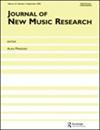在无调性语境中听四和弦
IF 1.1
4区 计算机科学
Q4 COMPUTER SCIENCE, INTERDISCIPLINARY APPLICATIONS
引用次数: 0
摘要
这项研究考察了对四和弦的感知。音乐家被分成四组。一组人听到了以[0167]为主的Bartók作品;其他小组听到它重新组合,将[0167]的任何实例替换为[0184]、[0268]或[0257]。对熟悉前后评分的分析表明,参与者从熟悉中识别出四弦琴,无论哪一组在熟悉中表现突出,尽管听真实音乐很困惑。与动机音程相似的四和弦在熟悉后也被评为更高。值得注意的是,参与者展示了从熟悉时的旋律表现到评级阶段的和声表现的概括能力。本文章由计算机程序翻译,如有差异,请以英文原文为准。
Hearing tetrachords in an atonal context
This study examines the perception of tetrachords. Musicians were divided into four groups. One group heard a Bartók composition predominated by [0167]; other groups heard it recomposed with any instance of [0167] replaced with [0148], [0268], or [0257]. Analysis of ratings before and after familiarisation suggests that participants recognized the tetrachord from familiarisation, no matter which set-class was prominent in familiarisation and despite confounds of hearing real music. Tetrachords with similar intervals to the motive were also rated higher after familiarisation. Notably, participants demonstrated ability to generalise from a melodic presentation in familiarisation to a harmonic presentation in ratings phases.
求助全文
通过发布文献求助,成功后即可免费获取论文全文。
去求助
来源期刊

Journal of New Music Research
工程技术-计算机:跨学科应用
CiteScore
3.20
自引率
0.00%
发文量
5
审稿时长
>12 weeks
期刊介绍:
The Journal of New Music Research (JNMR) publishes material which increases our understanding of music and musical processes by systematic, scientific and technological means. Research published in the journal is innovative, empirically grounded and often, but not exclusively, uses quantitative methods. Articles are both musically relevant and scientifically rigorous, giving full technical details. No bounds are placed on the music or musical behaviours at issue: popular music, music of diverse cultures and the canon of western classical music are all within the Journal’s scope. Articles deal with theory, analysis, composition, performance, uses of music, instruments and other music technologies. The Journal was founded in 1972 with the original title Interface to reflect its interdisciplinary nature, drawing on musicology (including music theory), computer science, psychology, acoustics, philosophy, and other disciplines.
 求助内容:
求助内容: 应助结果提醒方式:
应助结果提醒方式:


